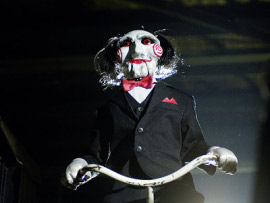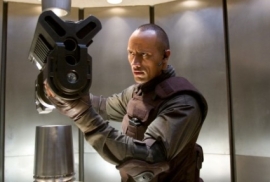 SAW II
SAW II
Since we're no longer forced to endure Cary Elwes shrieking his hammy little head off for 90 minutes, Saw II was inevitably going to be a less annoying experience than 2004's Saw, but the movie is pretty effective in its own right. Not entertaining, mind you, but effective. Last fall's surprise horror hit saw Elwes and another mad overactor at the mercy of the serial killer Jigsaw (Tobin Bell) - who devises for his prey wildly elaborate devices of torture that defy both description and belief - and in one of Saw II's few impressive twists, he's apprehended at the end of the movie's first reel. What follows resembles what might result if you watched The Silence of the Lambs and Seven in picture-in-picture format. As Jigsaw - in sinister, I-know-something-that-you-don't Hannibal Lecter mode - is interrogated, and his master plan dissected, by Donnie Wahlberg's quick-to-boil cop, a whole new slew of potential victims, including Wahlberg's teenage son, try to survive a vicious spook house by evading Jigsaw's contraptions and deconstructing the maddeningly obtuse sets of clues the killer has left them. (Like its precursor, Saw II makes explicit what Seven left to your imagination.)
I will forever recollect watching John Carpenter's uber-gruesome remake of The Thing and listening to the audience wince and moan when a character slit his thumb with a scalpel - in Carpenter's movie, entrails were spewed across the screen, a man's head literally separated itself from its torso, a dog got turned inside out, for Pete's sake, yet that thumb-slice was the moment that made the crowd collectively recoil. It was an agony the audience could relate to, and the Saw films, for better or worse, are remarkably canny about knowing how to freak people out - who hasn't endured the shock and pain of accidentally drawing their own blood? In Saw II, a man is put in the position of having to cut out his eye and another slices off a chunk of his neck, and these atrocities are presented, by director Darren Lynn Bousman, in full, gory close-up - the movie often resembles your ultimate shaving nightmare. And when a woman falls into a pit of hypodermics, anyone who's ever gotten woozy at the thought of donating blood would do well to keep their eyes shut; for belonephobes, the sequence may be nearly unbearable.
Saw II is just low-rent enough for these horrors to be both palpably grisly and distressingly believable, but that doesn't necessarily translate into being enjoyable. Despite the director's skill, the only true fun to be had in the movie lies in the performance of Tobin Bell, whose sneaky line readings and apathetic viciousness give the movie some texture - at times, with his laser-beam stare shooting out from behind the decaying ashiness of his face, Bell's Jigsaw resembles F. Murray Abraham's aged Salieri in sociopath drag. Yet despite Bell's contributions and a finale that's, surprisingly, not a total letdown, Saw II is a grim and unpleasant experience; the movie works, but I'm still not fully on-board with how it works.
 DOOM
DOOM
Action movies - at least, those geared to the late-teen, early-twentysomething demographic - have become increasingly indistinguishable from video games; soon, concession stands will begin offering a deal on a large popcorn, soda, and analog stick. Yet if kinetic Hollywood thrill rides continue on this trajectory - and there's no reason to think they won't - we could certainly do worse than Doom, director Andrzej Bartowiak's film version of the beloved gaming staple. Here, The Rock and a team of military lunch meat, on an ill-advised outer-space rescue mission, spend more than an hour blasting the hell out of mutant meanies, and the movie is smart enough to not even pretend it's anything but a video game; near the climax, in the film's most inspired sequence, the camera assumes a five-minute-long, first-person perspective (only the character's weapon is visible), giving audiences the sensation of actually playing the movie. Doom, which is almost a scene-by-scene retread of Aliens, is populated by stick figures and its dialogue is even more banal than the "character exposition" you endure in most X-Box entertainments. But it's an energetic and unpretentious sci-fi horror show, and it comes with a late-film plot twist that not only plays off The Rock's bad-ass screen persona beautifully, but blows the expected conventions of both sci-fi plotting and star casting to smithereens. That's a brand of screen violence I'm completely on board with.
 STAY
STAY
And while we're on the subject of video games ... .
I recently watched a friend play a violent, role-playing game in which his character was traveling, with seemingly no direction, through a labyrinth of corridors, often stopping to pick up random keys and maps and weapons. Regarding these items he was amassing, I'd occasionally ask, "What's that for?" and he'd smile and say, "I have no idea." It was the smile that got me; he didn't have the slightest clue as to the articles' eventual purpose, but the collection of them sure made him happy. That's how I felt throughout much of Stay. In the movie, Ryan Gosling plays a suicidal artist, Ewan McGregor plays his psychologist, Naomi Watts plays another artist who used to be suicidal, and there's much doubling (and tripling) involved among the characters; we spend our time at director Marc Forster's and screenwriter David Benioff's work trying to figure out if Gosling is really McGregor, or if McGregor is really Gosling, or if Watts is (again) just a figure in a Lynchian dream - the movie is like Jacob's Ladder where the ladder leads nowhere. The film is an unholy mess, but at least it's well-performed, with some astonishingly clever scene transitions, and it's chockablock with leitmotifs and symbols ripe for later analysis; Stay is one of those unsatisfying mind-benders in which you have no doubt the DVD commentary track will prove more fascinating - and probably a lot more lucid - than the movie itself.
 PRIME
PRIME
Meryl Streep is such a gloriously inventive comedienne that she can even make something as formulaic and simplistic as writer/director Ben Younger's Prime feel occasionally witty. Playing a tightly wound Jewish therapist whose son finds love outside his faith and age bracket, Streep keeps audiences alert by letting us read her incredibly precise, brilliantly farcical emotional transitions - high comedy is going on in her head - and she can make the simple act of drinking a glass of water feel like a routine Buster Keaton would have been proud of. For all its sincerity, Prime is a throwaway wisp of a movie; it plays like something that's been gathering dust in Woody Allen's bottom drawer for far too long. Yet Streep - even when hindered by the hideous hairdo she's stuck with here - is a delight, and Uma Thurman is spectacularly assured and captivating; she creates a fully fleshed-out character with the subtlest of brushstrokes. That's right, folks. Uma Thurman is now playing the December role in a May-December romance. I officially want to kill myself.










